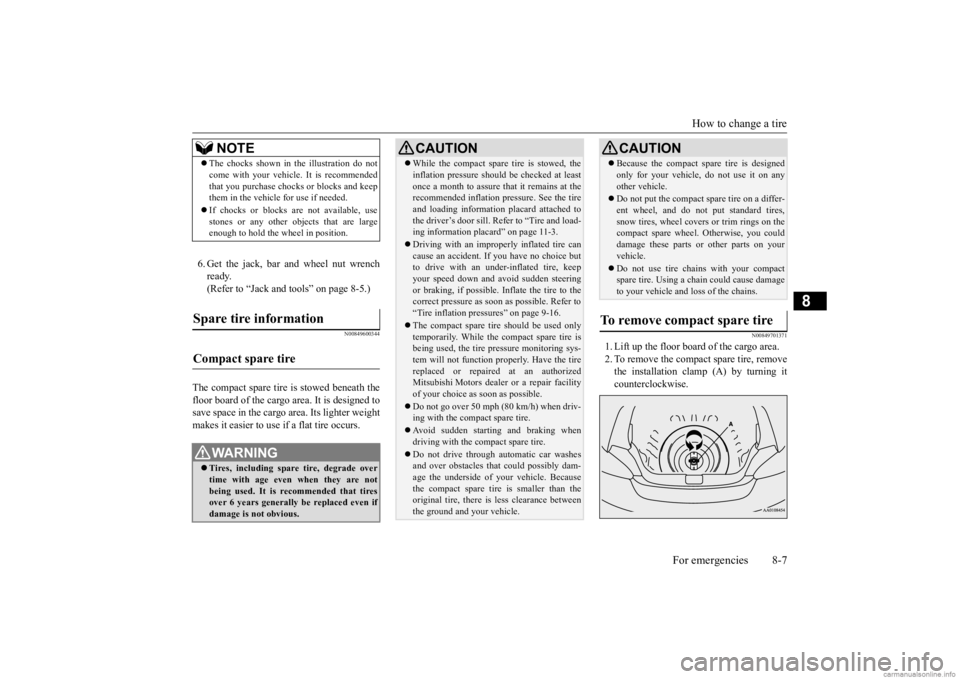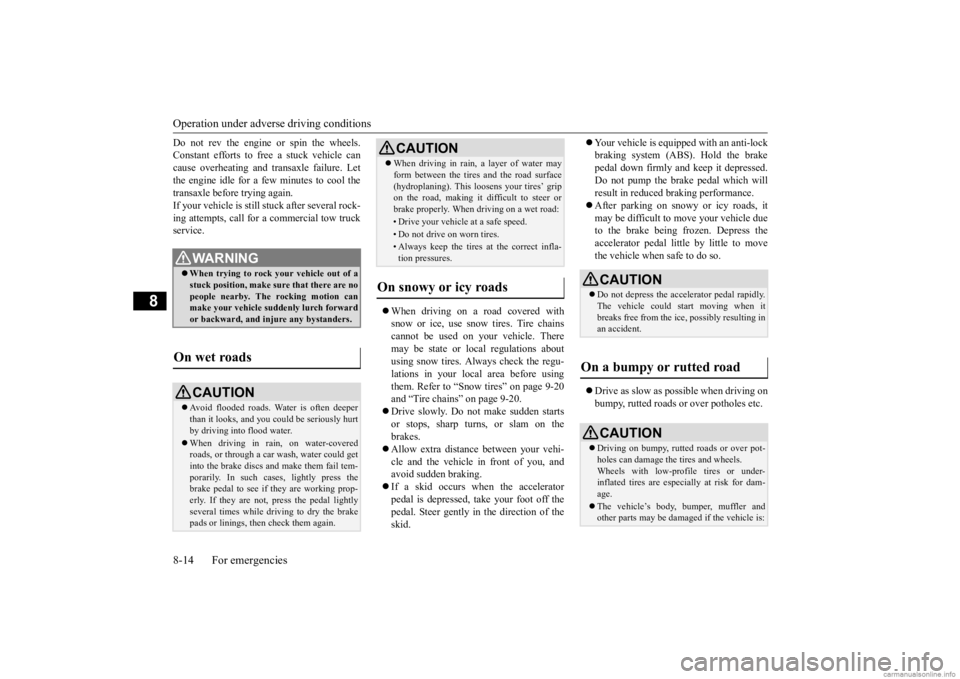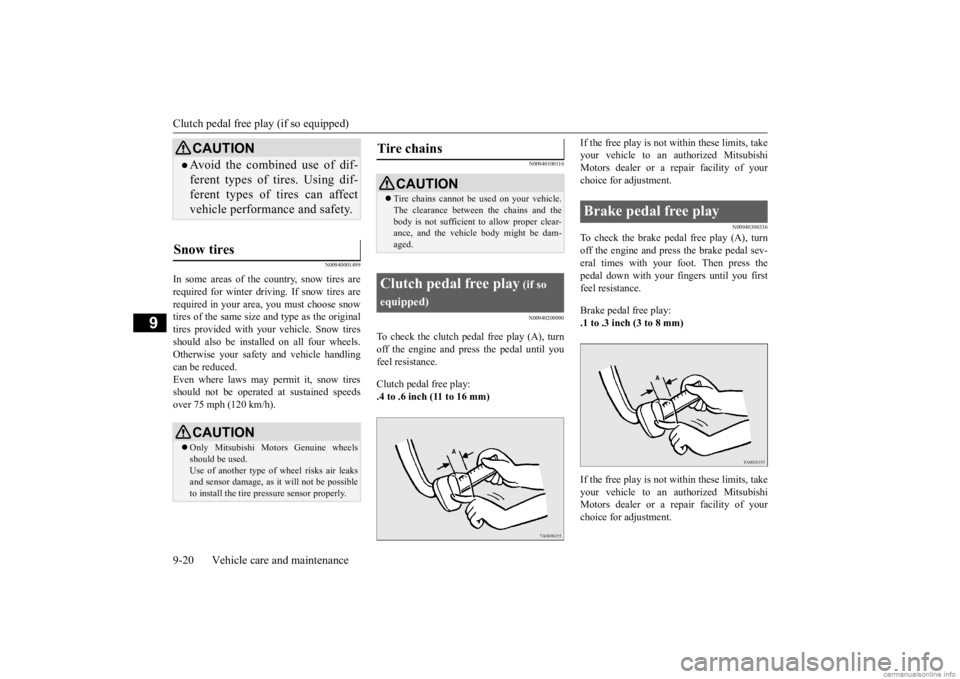snow chains MITSUBISHI MIRAGE G4 2020 Owner's Manual (in English)
[x] Cancel search | Manufacturer: MITSUBISHI, Model Year: 2020, Model line: MIRAGE G4, Model: MITSUBISHI MIRAGE G4 2020Pages: 253, PDF Size: 36.39 MB
Page 188 of 253

How to change a tire
For emergencies 8-7
8
6. Get the jack, bar and wheel nut wrench ready. (Refer to “Jack and t
ools” on page 8-5.)
N00849600344
The compact spare tire is stowed beneath the floor board of the cargo area. It is designed to save space in the cargo area. Its lighter weightmakes it easier to use if a flat tire occurs.
N00849701371
1. Lift up the floor board of the cargo area. 2. To remove the compact spare tire, remove the installation clamp (A) by turning itcounterclockwise.
NOTE
The chocks shown in the illustration do not come with your vehicl
e. It is recommended
that you purchase chocks or blocks and keepthem in the vehicle for use if needed. If chocks or blocks
are not available, use
stones or any other obj
ects that are large
enough to hold the wheel in position.
Spare tire information Compact spare tire
WA R N I N G Tires, including spar
e tire, degrade over
time with age even when they are notbeing used. It is recommended that tires over 6 years generally
be replaced even if
damage is not obvious.
CAUTION While the compact spare tire is stowed, the inflation pressure shoul
d be checked at least
once a month to assure that it remains at therecommended inflation pressure. See the tire and loading informati
on placard attached to
the driver’s door sill. Refer to “Tire and load-ing information placard” on page 11-3. Driving with an imprope
rly inflated tire can
cause an accident. If
you have no choice but
to drive with an under-inflated tire, keep your speed down and av
oid sudden steering
or braking, if possible. Inflate the tire to the correct pressure as soon as possible. Refer to “Tire inflation pressures” on page 9-16. The compact spare tire should be used only temporarily. While th
e compact spare tire is
being used, the tire pr
essure monitoring sys-
tem will not function
properly. Have the tire
replaced or repaired at an authorizedMitsubishi Motors dealer
or a repair facility
of your choice as soon as possible. Do not go over 50 mph (80 km/h) when driv- ing with the compact spare tire. Avoid sudden starting and braking when driving with the compact spare tire. Do not drive through automatic car washes and over obstacles that
could possibly dam-
age the underside of your vehicle. Becausethe compact spare tire is smaller than the original tire, there is less clearance between the ground and your vehicle.
Because the compact spare tire is designed only for your vehicle, do not use it on anyother vehicle. Do not put the compact spare tire on a differ- ent wheel, and do not put standard tires,snow tires, wheel covers
or trim rings on the
compact spare wheel. Otherwise, you could damage these parts or other parts on yourvehicle. Do not use tire chains with your compact spare tire. Using a chain could cause damage to your vehicle and loss of the chains.
To remove compact spare tire
CAUTION
BK0284300US.book 7 ページ 2019年5月23日 木曜日 午後12時22分
Page 195 of 253

Operation under adverse driving conditions 8-14 For emergencies
8
Do not rev the engine or spin the wheels. Constant efforts to free a stuck vehicle cancause overheating and tr
ansaxle failure. Let
the engine idle for a few minutes to cool the transaxle before trying again.If your vehicle is still
stuck after several rock-
ing attempts, call for a commercial tow truck service.
When driving on a road covered with snow or ice, use snow tires. Tire chainscannot be used on your vehicle. There may be state or local regulations about using snow tires. Always check the regu-lations in your local area before using them. Refer to “Snow tires” on page 9-20 and “Tire chains” on page 9-20. Drive slowly. Do not make sudden starts or stops, sharp turns, or slam on the brakes. Allow extra distance
between your vehi-
cle and the vehicle in front of you, and avoid sudden braking. If a skid occurs when the accelerator pedal is depressed, take your foot off the pedal. Steer gently in the direction of theskid.
Your vehicle is equipped with an anti-lock braking system (ABS). Hold the brakepedal down firmly and keep it depressed. Do not pump the brake pedal which will result in reduced braking performance. After parking on snowy or icy roads, it may be difficult to move your vehicle due to the brake being frozen. Depress theaccelerator pedal little by little to move the vehicle when safe to do so. Drive as slow as possible when driving on bumpy, rutted roads or over potholes etc.
WA R N I N G When trying to rock
your vehicle out of a
stuck position, make sure that there are no people nearby. The
rocking motion can
make your vehicle suddenly lurch forwardor backward, and inju
re any bystanders.
On wet roads
CAUTIONAvoid flooded roads. Water is often deeper than it looks, and you
could be seriously hurt
by driving into flood water. When driving in rain, on water-covered roads, or through a car wash, water could get into the brake discs and make them fail tem-porarily. In such cases, lightly press the brake pedal to see if they are working prop- erly. If they are not, press the pedal lightlyseveral times while driving to dry the brake pads or linings, then check them again.
When driving in rain, a layer of water may form between the tires and the road surface(hydroplaning). This loosens your tires’ gripon the road, making it difficult to steer or brake properly. When driving on a wet road:• Drive your vehicle at a safe speed.• Do not drive on worn tires.• Always keep the tires at the correct infla- tion pressures.
On snowy or icy roads
CAUTION
CAUTION Do not depress the acce
lerator pedal rapidly.
The vehicle could start moving when itbreaks free from the ice, possibly resulting in an accident.
On a bumpy or rutted road
CAUTION Driving on bumpy, rutted roads or over pot- holes can damage the tires and wheels. Wheels with low-profile tires or under-inflated tires are especially at risk for dam- age. The vehicle’s body, bumper, muffler and other parts may be dama
ged if the vehicle is:
BK0284300US.book 14 ページ 2019年5月23日 木曜日 午後12時22分
Page 217 of 253

Clutch pedal free play (if so equipped) 9-20 Vehicle care and maintenance
9
N00940001499
In some areas of the country, snow tires are required for winter driving. If snow tires are required in your area, you must choose snow tires of the same size
and type as the original
tires provided with your vehicle. Snow tires should also be installe
d on all four wheels.
Otherwise your safety and vehicle handlingcan be reduced. Even where laws may permit it, snow tires should not be operated
at sustained speeds
over 75 mph (120 km/h).
N00940100116 N00940200090
To check the clutch pedal free play (A), turn off the engine and pr
ess the pedal until you
feel resistance. Clutch pedal free play: .4 to .6 inch (11 to 16 mm)
If the free play is not within these limits, take your vehicle to an authorized MitsubishiMotors dealer or a repair facility of your choice for adjustment.
N00940300336
To check the brake pedal free play (A), turnoff the engine and press the brake pedal sev- eral times with your foot. Then press the pedal down with your fingers until you first feel resistance. Brake pedal free play: .1 to .3 inch (3 to 8 mm) If the free play is not within these limits, take your vehicle to an authorized Mitsubishi Motors dealer or a repair facility of yourchoice for adjustment.
CAUTIONAvoid the combined use of dif- ferent types of tires. Using dif- ferent types of tires can affect vehicle performance and safety.
Snow tires
CAUTION Only Mitsubishi Motors Genuine wheels should be used.Use of another type of
wheel risks air leaks
and sensor damage, as
it will not be possible
to install the tire pressure sensor properly.
Tire chains
CAUTION Tire chains cannot be used on your vehicle. The clearance between
the chains and the
body is not sufficient
to allow proper clear-
ance, and the vehicle body might be dam- aged.
Clutch pedal free play
(if so
equipped)
Brake pedal free play
BK0284300US.book 20 ページ 2019年5月23日 木曜日 午後12時22分
Page 249 of 253

Alphabetical index 12-4
12
Replacement
..................................
9-32
Rear seat
..............................................
4-5
Rear side-marker lights
Bulb capacity
.................................
9-29
Replacement
..................................
9-32
Rear turn signal lights
Bulb capacity
.................................
9-29
Replacement
..................................
9-32
Rear-view camera
...............................
5-62
Rearview mirror
Inside rearview mirror
.....................
5-34
Outside rearview mirrors
.................
5-36
Replacement of light bulbs
..................
9-28
Replacing tires and wheels
..................
9-18
Reporting Safety Defects
.....................
10-2
S
Safe driving techniques
.........................
6-4
Seat belts
.............................................
4-7
Adjustable seat belt shoulder anchor
.4-12
Child restraint systems
....................
4-14
Front passenger seat belt warning light
.....
4-11 Maintenance and inspection
.............
4-22
Seat belt extender
...........................
4-13
Seat belt force limitter system
..........
4-14
Seat belt
instructions
.........................
4-8
Seat belt pr
e-tensioners
...................
4-13
Seat belt use
during pregnancy
.........
4-13
Seats
...................................................
4-2
Arm rest
....................................
4-4
, 4-5
Front seats
.......................................
4-2
Head restraints
.................................
4-5
Heated seats
.....................................
4-4
Seats and restraint systems
................
4-2
Service brake
......................................
5-46
Service precautions
..............................
9-2
Side turn signal lights
Bulb capacity
..................................
9-29
Snow tires
..........................................
9-20
Spark plugs
.........................................
9-22
Starting the engine
...............................
5-38
Steering
Electric power stee
ring system (EPS) 5-51
Steering wheel height adjustment
......
5-34
Stop lights
Bulb capacity
..................................
9-29
Replacement
...................................
9-32
Storage spaces
....................................
5-87
Sun visors
...........................................
5-84
Supplemental Re
straint System
.............
4-22
How the Supplemental Restraint System works
...........................................
4-25
Maintenance service
........................
4-36
T
Tail lights
Bulb capacity
..................................
9-29
Replacement
..................................
9-32
Tank capacity
.....................................
11-6
Ticket holder
......................................
5-85
Tire pressure moni
toring system (TPMS)
......
5-58 Tires
..................................................
9-12
Inflation pressures
..........................
9-16
Maintenance
...................................
9-18
Quality grading
..............................
10-2
Replacing tires and wheels
..............
9-18
Rotation
.........................................
9-18
Size (tire and wheel)
.......................
11-5
Snow tires
......................................
9-20
Tire and loading information placard 11-3 Tire chains
.....................................
9-20
To change a tire
................................
8-6
Tread wear indicator
.......................
9-18
Tools
...................................................
8-5
Storage
............................................
8-5
Towing
..............................................
8-12
Trailer towing
.....................................
6-12
Trunk lid
............................................
5-28
Trunk room light
Bulb capacity
.................................
9-30
Turn signal light
Indicators
.......................................
5-75
Lever
.............................................
5-79
BK0284300US.book 4 ページ 2019年5月23日 木曜日 午後12時22分